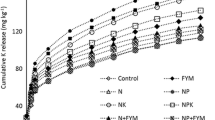Summary
The objective of this research is to evaluate the influence of soil water content on
-
- the mobility of potassium in soil,
-
- plant growth and
-
- K uptake of plants.
The mobility of K increased with soil moisture. Increasing the volumetric water content (θ) from the 0.1 to 0.4 resulted in a rise of the effective diffusion coefficient (De) by a factor of about 10. This is mainly due to the increase of the tortuosity or impedance factor with higher soil moisture.
In order to relate K mobility in soil to the availability of K for plant uptake, onion plants were grown in special containers under constant water content in the range of 0.1 to 0.4 cm3 H2O cm−3 of soil. Results are
-
- both K content and growth of the plants increased with soil moisture,
-
- water content below θ=0.1 reduced root growth
-
- K inflow per unit of root surface increased with soil moisture. Maximum rate of inflow occurred with θ=0.25 in the soil used.
It is therefore concluded that soil moisture affected K availability by affecting both K mobility and root growth.
Zusammenfassung
Die Arbeit hat das Ziel, den Einfluss des Wassergehaltes des Bodens auf
-
- die Mobilität der Kaliumionen im Boden,
-
- das Pflanzenwachstum und
-
- die K-Aufnahme
Zu bestimmen. Hierzu wurden einerseits Messungen der Mobilität von Kalium im Boden durch-geführt. Sie ergaben eine Erhöhung des effektiven Diffusionskoeffizienten (De) mit ansteigendem volumetrischen Wassergehalt (θ). De nahm um mehr als das Zehnfache zu während θ von 0,1 auf 0,4 anstieg. Dies ist der Erhöhung des Tortuositäts-oder Widerstands-faktors mit steigendem Wassergehalt zuzuschreiben. Um zu prüfen, in welchem Masse die Diffusionsbedingungen im Boden die Pflanzenverfügbarkeit von Kalium beeinflussen, wurde ein Vegetationsversuch durchgeführt. Hierzu wurden Zwiebelpflanzen in speziellen Versuchsgefässen bei konstanten Wassergehalten zwischen 0,1 und 0,4 cm3 H2O/cm3 Boden kultiviert. Die Ergebnisse sind:
-
- K-Konzentration und Ertrag der Pflanzen wurden mit zunehmedem Bodenwassergehalt erhöht.
-
- Der Wassergehalt des Bodens beeinflusste das Wurzelwachstum; unter θ=0,1 nahm die Wurzellänge stark ab.
-
- Die K-Aufnahmerate eines Wurzelabschnitts stieg mit dem Wassergehalt an; bei θ=0,25 war die maximale Aufnahmerate in diesem Boden erreicht.
Bie niedrigem Wassergehalt des Bodens wird die Kalium-Verfügbarkeit demnach beeinträchtigt sowohl durch den Rückgang der Mobilität von Kalium im Boden als auch die Verringerung des Wurzelwachstums.
Similar content being viewed by others
References
Adams F 1974 Soil Solution.In The Plant Root and its Environment Ed. E W Carson University Press of Virginia, Charlottesville.
Barber S A 1959 Relation of fertilizer placement to nutrient uptake and crop yield. II. Effects of row potassium, potassium soil-level, and precipitation. Agron. J. 51, 97–99.
Barber S A 1962 A diffusion and mass flow concept of soil nutrient availability. Soil Sci. 93, 39–49.
Barraclough P B and Tinker P B 1981 The determination of ionic diffusion coefficients in field soils. I. Diffusion coefficients in sieved soils in relation to water and bulk density. J. Soil Sci. 32, 225–236.
Claassen N and Jungk A 1982 Kaliumdynamik im wurzelnahen Boden in Beziehung zur Kaliumaufnahme von Maispflanzen. Z. Pflanzenernaehr. Bodenkd. 145, 513–525.
Evans G C 1972 The Quantitative Analysis of Plant Growth. Studies in Ecology. Vol. I. University of California Press.
Grimme H and Braunschweig von L C 1974 Interaction of K concentration in the soil solution and soil water content of K diffusion. Z. Pflanzenernaehr. Bodenkd. 137, 147–158.
Hartge K H 1971 Die physikalische Untersuchung von Böden. Ferdinand Enke Verlag, Stuttgart.
Hira G S and Singh N T 1977 Observed and predicted rates of phosphorus diffusion in soils of varying bulk density and water content. Soil Sci. Soc. Am. J. 41, 537–540.
Kuchenbuch R and Jungk A 1982 A method for determining concentration profiles at the soil-root interface by thin slicing rhizospheric soil. Plant and Soil 68, 391–394.
Mengel K and Braunschweig von L C 1972 The effect of soil moisture upon the availability of potassium and its influence on the growth of young maize plants (Zea mays L.). Soil Sci. 114, 142–148.
Newman E J 1966 A method of estimating the total root length in a sample. J. Appl. Ecol. 3, 139–145.
Nye P H 1966 The measurement and mechanism of ion diffusion in soil. I. The relation between self-diffusion and bulk diffusion. J. Soil Sci. 17, 16–23.
Paauw van der F 1958 Relations between the potash requirement of crops and meterological conditions. Plant and Soil 9, 254–268.
Pearson R W 1966 Soil environment and root development.In Plant Environment and Efficient Water Use. American Society of Agronomy Publications.
Place G A and Barber S A 1964 The effect of soil moisture and rubidium concentration on diffusion and uptake of rubidium-86. Soil Sci. Soc. Am. Proc. 28, 239–243.
Rowell D L, Martin H W and Nye P H 1967 The measurement and mechanism of ion diffusion in soils. III. The effect of moisture content and soil solution concentration on the self diffusion of ions in soils. J. Soil Sci. 18, 204–222.
Schaff B E and Skogley E O 1982 Diffusion of potassium, calcium and magnesium in Bozeman silt loam as influenced by temperature and moisture. Soil Sci. Soc. Am. J. 46, 521–524.
Scott H D and Paetzold R F 1978 Effects of soil moisture on the diffusion coefficients and activation energies of tritiated water, chloride and metribuzin. Soil Sci. Am. J. 42, 23–26.
Vaidyanathan L V and Nye P H 1966 The measurement and mechanism of ion diffusion in soils. II. An exchange resin paper method for measurement of the diffusive flux. J. Soil Sci. 17, 175–183.
Warncke D D and Barber S A 1972 Diffusion of zinc in soil. I. The influence of soil moisture. Soil Sci. Soc. Am. Proc. 36, 39–42.
Author information
Authors and Affiliations
Rights and permissions
About this article
Cite this article
Kuchenbuch, R., Claassen, N. & Jungk, A. Potassium availability in relation to soil moisture. Plant Soil 95, 221–231 (1986). https://doi.org/10.1007/BF02375074
Received:
Revised:
Issue Date:
DOI: https://doi.org/10.1007/BF02375074




